How to connect electricity from a pole to a house
Work on connecting the cable from the power line pole to the input junction box on the house should be carried out by a specialized organization: this site is too important. Nevertheless, you need to decide on the method of entry - overhead or underground - as well as the type of cable and its cross-section. So you have to figure out how you can connect electricity from the pole to the house and choose your option.
Electrical supply by air
The air method of power supply is attractive in that it does not require a lot of time and money. But the standards set requirements that not all houses meet:
- The cable entry into the house should be located at a height of at least 2.75 m. If the height of the house is sufficient, a distribution board with an RCD is mounted on the wall, and the cable from the pole is connected to it. If the house has a lower height, a special rack (pipe rack) is installed. It can be a curved shape called "gander" (in the picture on the left) or straight (in the picture on the right). These two input methods differ in the method of attachment to the walls of the house (see photo).
- The distance from the post to the point of entry should not exceed 10 m. If this distance is greater, an additional support is placed. From it to the power line, the distance should not be more than 15 m.
- Branch from power lines is done:
- up to 10 m - with a copper wire with a cross section of 4 mm;
- from 10 to 15 m - a wire with copper conductors with a cross section of 6 mm.
- aluminum wires are used in any case at least 16 mm in diameter.
Although copper wires require a smaller diameter, they cost significantly more than aluminum ones. Therefore, the input of electricity into the house from the pole is most often made from cables with aluminum conductors. There are two ways:
- Pull the torso or wire between the pillars, attach a current-carrying cable to it on special clamps.
- Use self-supporting wires, for which support is not needed: SIP (self-supporting insulated wire). It is connected using:
- insulators (glass, polymer, porcelain);
- special fittings.
Special fittings have appeared not so long ago, but are becoming more and more popular. It has a certain margin of safety. When it is exceeded (falling trees, massive snow melt, etc.), the reinforcement is destroyed, but the cable remains intact, the power supply is not disturbed.
From the place where the lead-in cable touches the wooden wall of the house and to the place where the shield is installed, the cable must be laid in a steel pipe
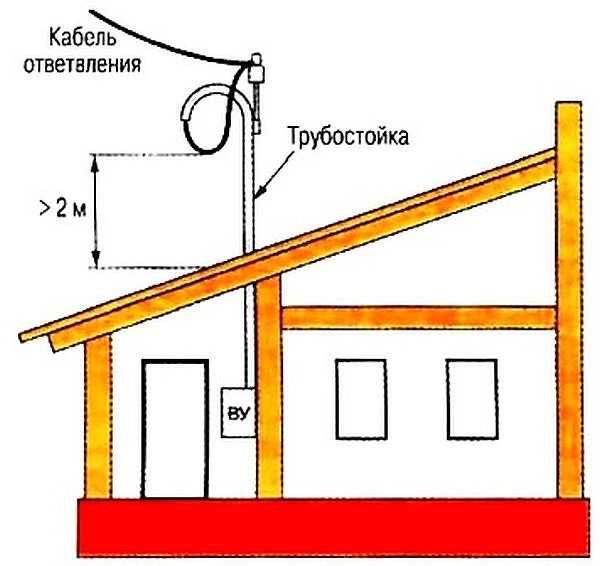
Entering electricity into the house from a pole through a pipe stand
The air supply of electricity to the house also has disadvantages:
- The electrical wiring is open, which may damage it.
- Hanging wires limit the possibilities at the entrance of large equipment (truck cranes, aerial platforms, etc.).
Underground (trench) electricity input
Another way to make the input of electricity into a wooden house is underground, through a trench.
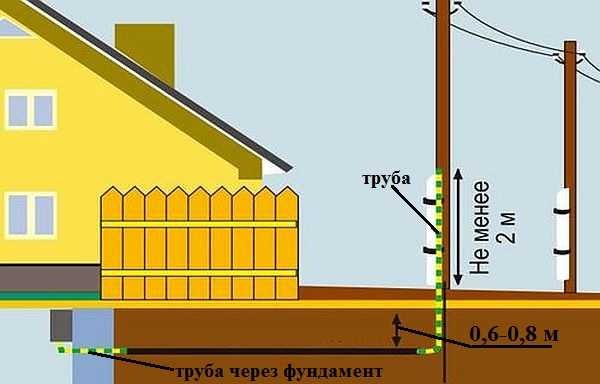
Entering electricity into a wooden house through a trench
In this case, the cable is lowered along the post inside the steel pipe, its height must be at least 2 m from the ground level. Then, from the post to the entrance to the house, a trench is dug. Its depth:
- 0.7 meters, when laying the cable in a plastic or asbestos pipe or under the protection of a brick (concrete) slab
- 1 m - no protection.
The power cable also enters the house in a metal pipe. It can be passed through the foundation (strip), but not under it. The second option is to raise the pipe along the wall by at least 2 meters, and at this height pass it through the wall, moreover, also in a metal pipe.
When connecting underground to a pole, it is recommended to use a power cable with copper conductors in reinforced insulation, better - armored. With a power consumption of less than 15 kW, there are no restrictions on the cross-section of copper conductors, but most often VBbShv cable with a conductor of 10 square millimeters is used.
All these works - up to connecting the power to the electricity meter and sealing it - must be carried out by a special organization. Self-connection is prohibited, and even threatens with fines: an agreed project and a certain level of access are required. But choose the type of connection, and then all the other work on the installation of electrical wiring in the house - you can do it yourself.
Read how to assemble an electrical panel here. It will be useful to read and about the rules for connecting wires in junction boxes.
Cable entry through a wooden house wall or foundation
If a self-supporting insulated wire or another conductor with aluminum conductors is laid from a post to a wooden house, according to the PUE, it cannot be introduced into the house: "It is not allowed to lay cables with aluminum conductors on combustible structures." A transition to copper is required. More often than others, VVGng cable is used for this purpose - in non-combustible insulation.
It should be remembered that terminal boxes are used to connect these two conductors, ordinary twisting is unacceptable. Directly bonded copper and aluminum enter into an active chemical reaction, quickly and strongly oxidize, which worsens the contact. As a result, even with low loads, a spark appears at the junction, and this is a direct path to a fire. Therefore, the use of terminal boxes is mandatory. They are in a sealed case, there are open ones. For outdoor use, of course, it is better sealed; you can also put open ones in the house.
But that's not all. The power cable can only be routed through a wooden wall through a thick-walled steel pipe. The pipe diameter must be at least 4 times the outer diameter of the wire. The wall thickness is normalized (SP 31-110-2003) and must be at least:
- 2.8 mm for a cable with a cross section of 4 sq. mm
- 3.2 mm for cables with 6-10 sq. mm.
It is desirable to position the entrance with a reverse slope so that water does not flow inside. Asbestos, rubber, or plastic plugs can be used to seal entry and exit points, and to ensure electrical safety. The edges of the pipe will need to be carefully processed and sanded to full smoothness so that the cable does not fray and its sheath is not damaged.
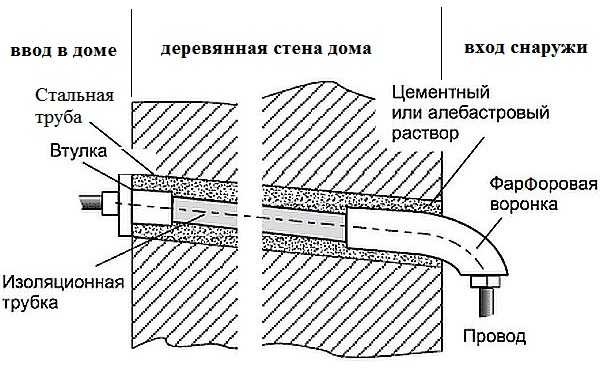
Electric cable entry through the wooden wall of the house
For calming and to increase reliability, the section that will be inside the pipe can be wrapped with asbestos thread or other insulating material. It can also fill the space inside the pipe to prevent insects from settling there. Another option is to fill the pipe with cement or alabaster mortar.
About, how to make wiring in a wooden house, read here.
When entering through the foundation, the situation is slightly different: the structure is no longer considered combustible, so you can use plastic mortgages. They are installed at the manufacturing stage. strip foundation... In this case, the passage for the cable differs depending on whether the room enters the cable: wet or dry.
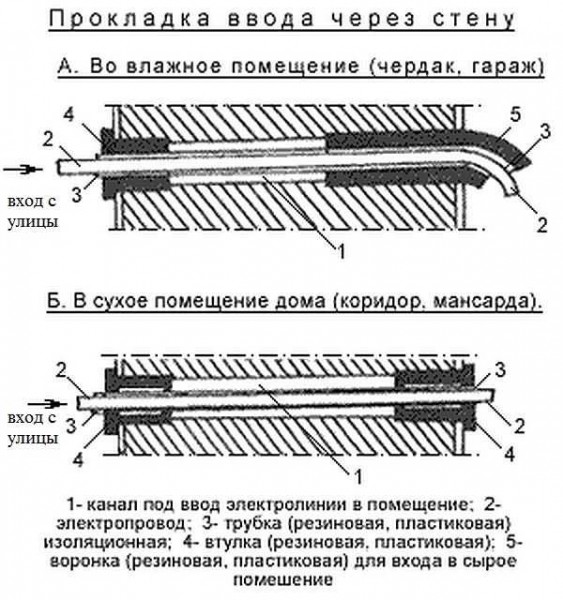
Electric cable entry through the foundation of the house
The spare parts necessary to organize the safe entry of electrics into the house do not cost very much, but they significantly increase the reliability, electrical and fire safety of your home. The constructions are quite simple, you can cope with their device with your own hands.

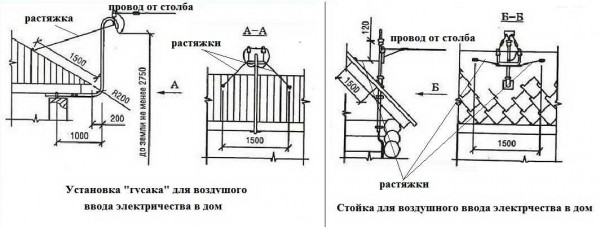
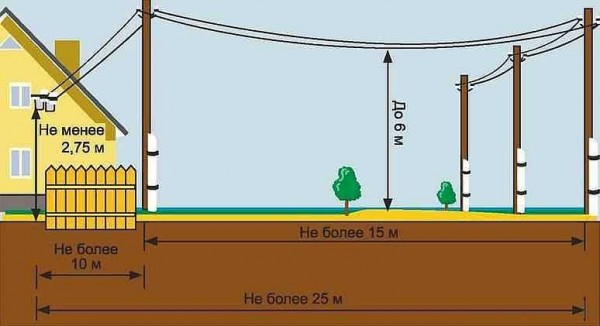
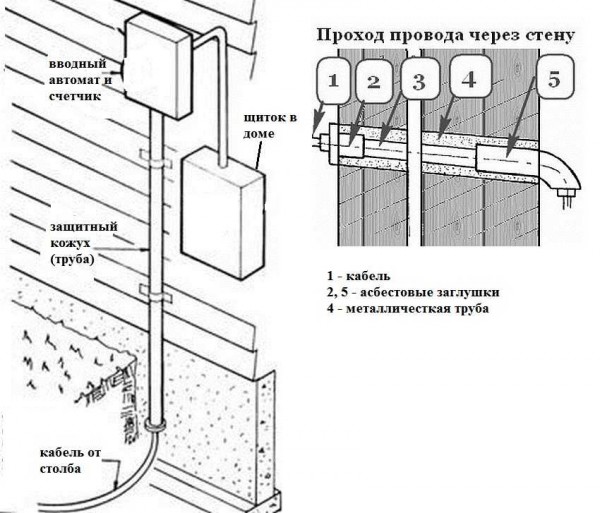
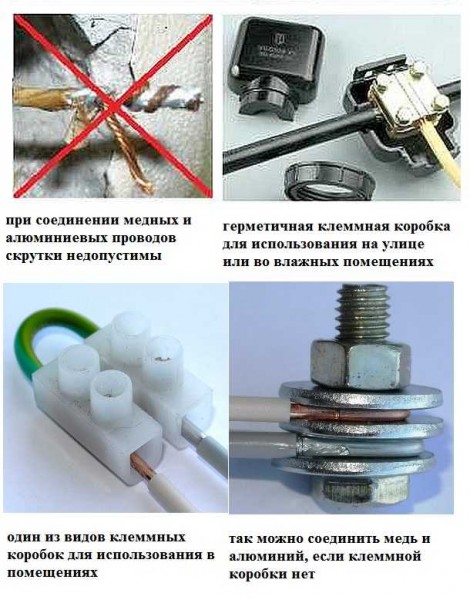
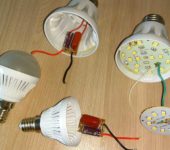

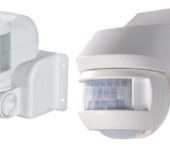
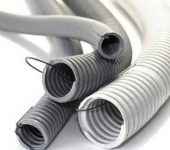
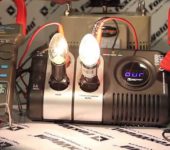





connecting a house to electricity from a pole is a problem in the event that a person does not understand electricity. for professionals, this is an everyday job. I was convinced of this when I turned to the company, they sent a ready-made, already assembled metering board, with all the necessary materials. I just nailed it to the wall and called the fitters from the network company.
the problem is only in collecting certificates and so on ... in physical terms, none)
Hello. The pillar is on the other side of the road (village). Have they built a new house, a little further than the old one (there was just a wire to this), how to extend the electricity to the new one))? Will they be forced to put a post or underground?
It's hard to say, but it looks like both options are suitable in your case. You can calculate what will be cheaper - put a pole or dig a trench - and choose. But it is better to call a specialist to tell you exactly how to connect electricity to your house.
Who are these professionals? A person with an advertisement in a newspaper, a firm, an office, etc. These are your general words. "A person who is not versed in electricity"))). If you ordered it, it means that you have nothing to do with it and that means you don’t understand electricity and will not be able, as an expert, to evaluate what was sent to you in terms of regulatory documents. You are not convinced of anything because you are not a specialist.
Good day!
And what is the reason for the 2.75 m norm for entering the house?
So according to the standard.
Good day! Can you give a link to the normative documentation?
Sorry, we do not publish links.
PUE (Bible for an electrician)
Is it forbidden to drip a trench on your site?
No, it is not prohibited. The electricity connection itself cannot be done on your own, but you can do all the preparatory work according to the project yourself.
Hello, please tell me which box and what must be used when laying wires into the house from the post. Earlier, from the post through the gander, the wires went to the meter, now there should be a box, the wife said otherwise they would not change the meter. It would be nonsense if it wasn't worth 10 thousand.
At my entrance from the post, first there is a counter, then a 25A difavtomat (connection in three phases with a 25A limitation). Is the schema correct?
There is a separate article on the selection of machine denominations (this here) and about connecting difavtomats (here).
When paying for the work of replacing the cable from the pole to the meter, I was warned that the arrival of the electricians' team was paid at the rate of 45 rubles per kilometer. Is it legal, why is it so expensive?
The electrician connected the wires from the pole to a straight line to the meter, making a hole in the wall. Without a gander. Was the job done right? The wire is hanging and no one is going to complete the work begun.
It's hard to say without a detailed description or photo of cable entry into the house. Although it looks like it was done wrong. You can do it without a gander, but the cable must be fixed on the wall in a special fastener that takes on the load, compensates for its change (wind, snow, icing).
Good afternoon, we have a village house for 2 families, there are two meters, ours and theirs. input 1 from the side of the neighbors' house and the cable show around the house with the outside of the house on the wall, the neighbors made an extension and cut off my cable, motivating that it interferes with them, what should I do in such a situation?
Write a complaint to Energosbyt. And look for a project. If everything is done according to the project, they are in serious trouble.
Hello, the house is 8 meters away from the post, we want to connect electricity, we were told to buy a VPS 16 cable from the post to the meter and from the meter to the house, we want to put the meter at 25 amperes, the question is which cable to buy (by air) single-core or multi-core? what brand to buy the counter? thanks
Hello! If the branch will be done with a zero wire, you need SIP-1 or SIP-2 (the second can withstand heating up to 90 ° C, the first up to 70 ° C). If without zero - SIP-4. It is better to buy a meter from the list of recommended ones; it should be on the website of your energy supplying organization. But there are usually electronic meters, although induction meters with an accuracy class of 2.0 can also be installed. If you want to put on an induction, ask whether they will accept it or not. It's hard to say about the brand specifically. Most often they put Energomera, but others are not much different.
The distance from the post to the house, on the one hand, and from the post to the village street gas pipeline, on the other hand, is much less than the height of the post. In case of collapse of the column towards the house, the house will collapse, towards the gas pipe - the pipe. There are norms for the installation of poles to residential premises and to the gas pipeline
Hello. I ask for advice !!! We bought a house, brought electricity into the house (input from the overhead line through the ground and not by air), there was a sealed electric meter. They began to draw up the documentation for themselves, power engineers arrived, wrote out an order - to change the outdated meter. They changed it, carried it to the outside of the house. We submitted an application for sealing and suddenly they refused us and required to make an input from the overhead line by air and put the meter on a pole, take it out into the street. Is their demand legitimate?
Hello! As for the legality, you need to look in the regulatory framework. Are the requirements in writing? If so, then most likely they are legitimate. If the instructions are verbal, ask for a complete list of requirements in writing. For what there is no reason, they will not put a signature and seal.
question: the house was turned off for non-payment, they cut off the wires, bought new ones, paid for everything, gave a receipt for payment for replacing the air input .... What kind of replacement is this if it's just a connection? is there a difference in price
You need to look at the rules in your area.
Good day. I have on. a box is installed on the post. SIP 16mm2 is carried out up to the entry bag. From the introductory bag (32 A) to the counter, a copper cable 4mm2, and from the counter again SIP 16mm2 to the house. I have a question: is the section of the installation copper cable of 4mm2 sufficient? (line 7kW). The house has a bag for 16A
For 7 kW minimum cable section... Given that you have a self-supporting insulated wire with a margin of up to 12 kW. About the choice of packet bags is another story ... 16A this machine is put on a wire of 2.5 mm2. About the choice of the machine's rating, read here) Actually, it is not dangerous, but when several powerful devices are turned on at the same time (or even one, but with a capacity of more than 2.8 kW), it should work (if it works).
Good day! I would like to know. On our site there is an old house and is connected to electricity (a pole on the side of the site) 3 kW, there is a meter and a personal account by which we pay for the light, that is, everything is official. Now a new house has been built on the same site, and I would like to transfer everything from the old house to the new one (without increasing the capacity) while maintaining the personal account, we will seal and register the new meter ourselves, if this is not possible, then leave the old meter while maintaining the same personal account ... Do you do this kind of work?
Good day! Our site is informational. We do not do any work.
Hello, if there are 2 houses on site, then the air input from the pole should be done separately for each house, on separate meters in them, or can you make an input into 1 meter in one house and from it lead a wire to the second house?
And immediately, if it is impossible to lead sequentially, through one house (meter) to the second, and it is necessary to make inputs to each house separately, then is it possible to use a gander attached to the roof of the first house instead of a pillar to extend the wire to the distant (second) house, since the second house is too far from the power line? Post is reluctant)
Hello! The answer can only be tied to the site plan, the location of the power grids. That is, you need to consult with your local electricity company.
Hello, we want to change the "bare" cable for an insulated one because we insulate the house for the purpose of electrical safety when working outside. In the regional center they made an application, paid. at home, we have to connect everything else ourselves, but 3 weeks have passed, and they only promise. Are there any time standards and who should connect the cable to the “home”?
I won't tell you about the timing, you need to look at the local regulatory framework. Workers must extend the line to your home, and either the local electrician or yourself (if you have experience) connects you. It will be possible to come to an agreement with the employees of the RES, but how much they ask is a question.
Hello, you can connect to the pole (the cable will run over the garage (the pole behind the garage)) what are the standards (goose height, sagging something else)?
Hello, I have such a question, they built a house 25 meters away there is a power line support, a three-phase brush is installed on it, now I want to conduct electricity from it to the house underground, I was told that it is necessary to conduct an armored wire and take zero and ground from the pole, so is it?
In general, yes. An armored cable is needed underground to reduce the risk of damage. And you can make the land your own - make a ground loop.
Where can I download the wiring diagram from the pole to the meter? Thank you !
Hello! Please tell me, I want to buy a plot, but it is in the field, and there are houses near the plot across the lakes, is it possible to stretch a cord across the lake to the light
Do you want to forward the temporary hut?
Good day. A house was built on the new site. I touched on the issue of connecting electricity, electricians arrived and refused to install the pole. The nearest post is located 42 meters across the road, the next one is 47 meters across the road. They say that the electricity plant in the house is only underground. Is it so?
Apparently, when installing the pole, the span will turn out to be too large. Moreover, the self-supporting insulated wire will hang over the roadway. In our settlement, I did not see the cable hanging on the road. In order not to guess, ask the electricians on the basis of what documents they refuse to throw air.
42 meters distance from the support to the entrance to the house, and on these 42 meters I wanted to put an intermediate support. It refers to the fact that the support will stand on the border of the plot.
A neighbor sued us to move the wires to our house, which are hung over his site. The court decided to move the wires. We wrote a statement to the organization serving the electrical network of our village, and attached the court decision. More than half a year has passed, and there is no answer from them, and accordingly, we cannot execute the court decision.Where to go, can I go to another organization or get the service network organization to perform work?
You can also go to another organization that has a license for these types of work.
Good day. In my country house (wooden, sheathed with siding) in 2007 a meter was installed (year of manufacture 1992, production of Romania). A cable is stretched from the post to the house (in my opinion, VVG is in black insulation, but I may be wrong because it was a long time ago), then it goes through the wall into the house and then along the wall of the room goes to the meter. The room is finished with clapboard, so it turned out that the cable runs inside the wall (closed wiring). All installation work was carried out by an electrician of our SNT, there are no twists or adhesions inside the cable (of this I am 100% sure). Now the question arose about replacing the meter, tk. the old one broke. The chairman with the electrician of our SNT insist (!!!) on taking him out into the street. I refuse. I installed the new meter (not myself, on a metal shield, on a DIN rail) in the old place in the house, the SNT electrician sealed it, but did not give an act of commissioning (!). His last excuse was: "The wire goes inside the wall and I can't see it." Questions: 1) Can the wire to the meter pass through the wall, based on what rules? 2) Are the chairman and electrician of our SNT right? How can I be in this situation?
Hello! Tell me, we have a cable supply from the pole to the house underground. 25 meters. Electricity 15 kW 380. The cable is buried in aluminum with a cross section of 4: 25. If you increase the power to 25 kW 380. Do you need to change the cable or is this enough?
It is necessary to change the cable. Read about the selection of the cable section here.
Hello ! I bought the house 2.5 years ago from the Developer, now we have a damaged cable from the pole to the house (underground), it turned out that it is shorting the floor in both bedrooms (from the corner of the house), it turns out that the cable goes into the wall of the house near the floor to the shield. Is it possible to install the input cable in the wall and in the foundation?
And another question. Can I give up the cable to the house, if in the act of delimiting the border along the lower terminals in the shield on the post, and I became the happy owner of 39 m of cable to my house, which also goes unclear where.
Hello. The cable passes through the neighboring area near the house. The wind shakes both the wire and the metal pole. How to be
Goodnight!
At SNT, they cut off the old power line and hung up everyone who paid for a new one with self-supporting insulated wires with wires and meters + consumables. But I did not immediately fit into this solution (i.e. old wires hang to my shed - on the post-pipe section, but the line is new from the self-supporting insulated wire). But this year I paid for everything. Those. without debt, as it were. They said you can connect.
I want to lead to my new house being built (the roof has just begun to be erected, for a long time), but I can connect the light. And the work is about to require light. Those. need to be connected soon.
Situation: My site does not have a concrete pillar. But it is available on the plots nearby. I counted my step from the nearest pillar to the corner of my house from a gas block 20-21. It supplies power to a section across the street and a section in a diagonal about the same as mine. I figured out my step 0.8-0.9 m using a roulette wheel. my step turns out. Those. 18 meters in total.
Question: from what should I put an underwater hook or a tower with insulators at the corner of a house from GB. Why the corner?
Because I will also need to bring a line from the house to the barn (I will update soon). I want a common shield for all buildings: house + shed. I really want to make sure that no complaints arise when decorating a house.
If you put a hook, then you need to think that it does not fly out of the aerated concrete.When the self-supporting insulated wire was being brought down in my new house, the electricians themselves screwed the hook into the wooden paneling. The meter costs one three-phase: for a garage, a house and a barn.
Good day!
A shield with a counter, automatic devices and an outlet is installed on the post. The house is 30m from it, 5 kW is allocated. Is it possible to bring a cable into the house in a metal hose with PVC over a fence or necessarily in the ground? And which cable is needed?
Good evening!
From the power transmission pole to the border of the site 10 meters, I wanted to lay a cable in the ground, they say I need to take a warrant for land work, because municipal land (village), To take an order you need to call a surveyor (15.0 thousand rubles) and a bunch of approvals. In the village there is nothing but electricity, the road and that dirt road. How to be? It's impossible by air, the neighbors are against it. Tell me how to get out of this situation at the lowest cost? Thank you.
Hello. We have a private house. There was a hurricane wind and a fungus flew off the gander and hangs on the wires. They called the power grid, but we were told that first we need to make a springboard on the roof, that they do not have to go out with the stairs. Is this legal?
Well done, that he called the electricians of the grid company - whose area of responsibility is from the corner support to the input insulators. Then the SC fitters do everything, they are responsible for the correct assembly of their junk and guarantee the quality.
Hello. SNT moved the pole to the other side of the site and stretched the wire (SIP) right through (from the old place, drilling holes in the house), along the attic ceiling (1.5 meters ceiling height, we touch the wire with our head). Is this acceptable and can I ask that the wire be laid around the perimeter of the house, and not through, as the electricians did.
I imagined a picture and thought it was some kind of game. It turns out that the electricians chose the simplest option for themselves without thinking about the tenants. I think we should demand that the CIP be led outside the house.
Good day. Village in the Moscow region. The old house was connected by air from the pole to the house. The pillar is 10 meters from the border of the site. There is a shield on the post. In the dashboard there is a counter and machines. The house burned down. The post with the flap and the counter remained. On my own, I ran a cable underground from the bathhouse to this post. Did I have the right to do this? And do I face any fines? Thank you.
And what kind of territory is located between the pillar and the site? Is there a possibility that earthworks will be carried out there?